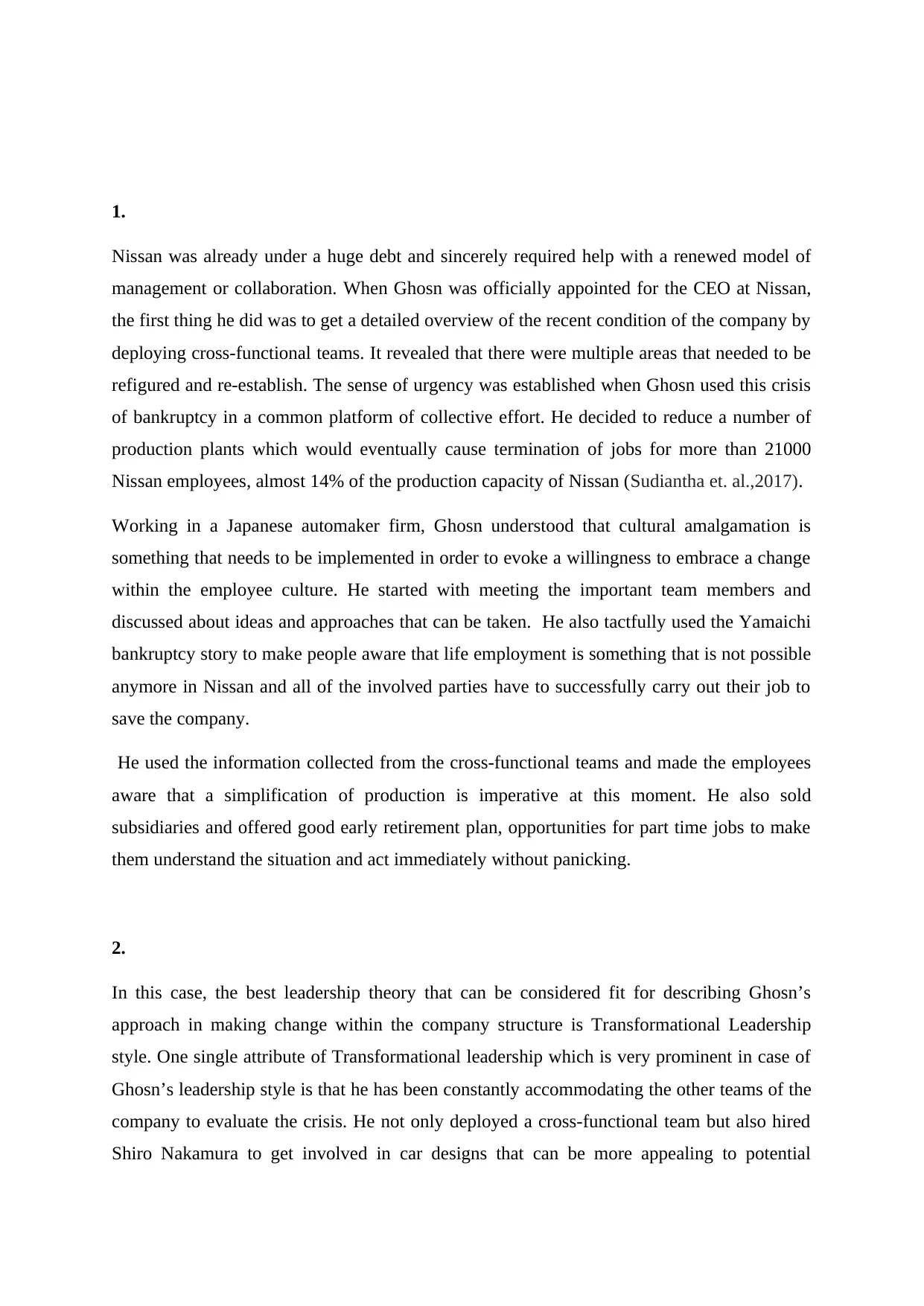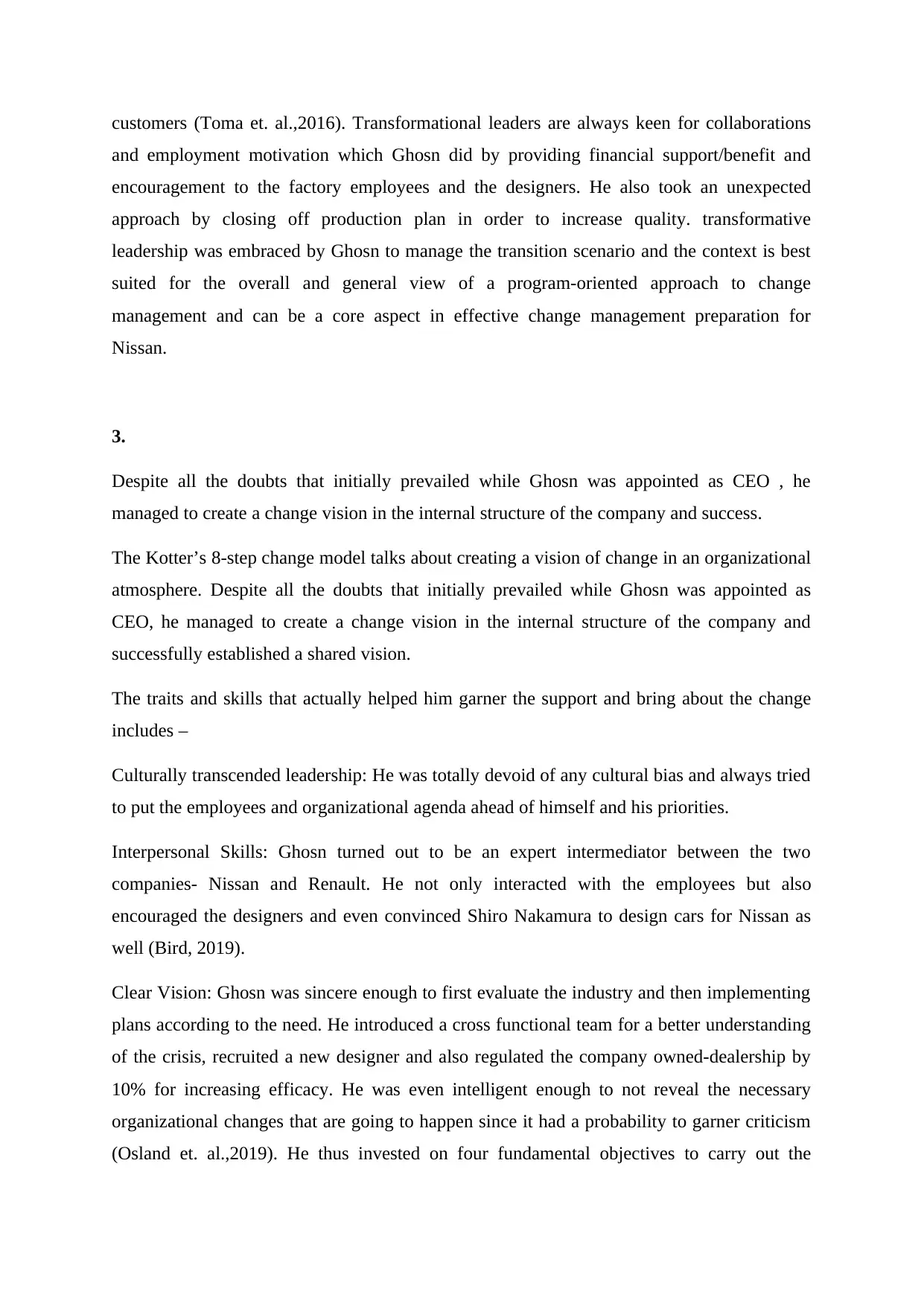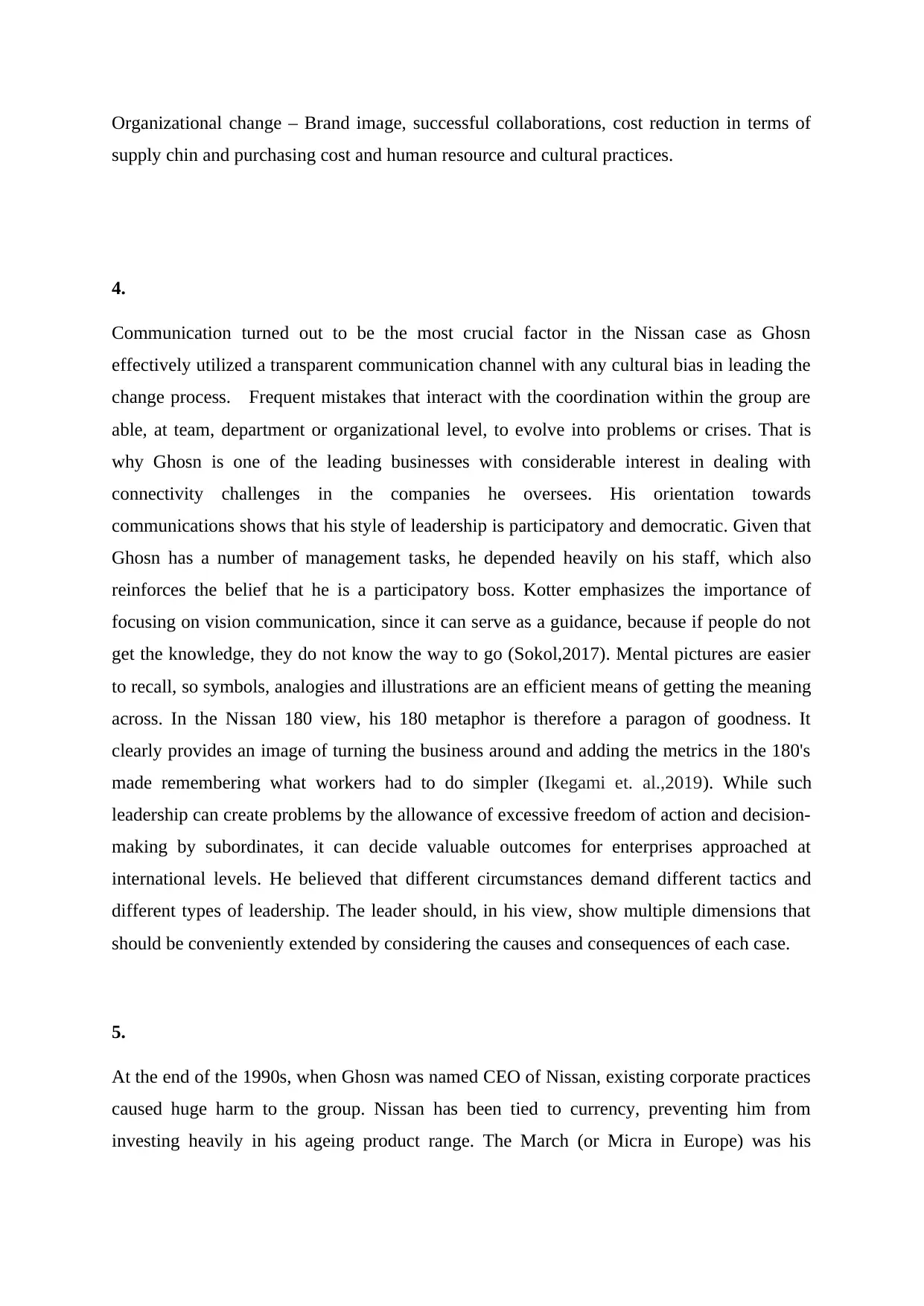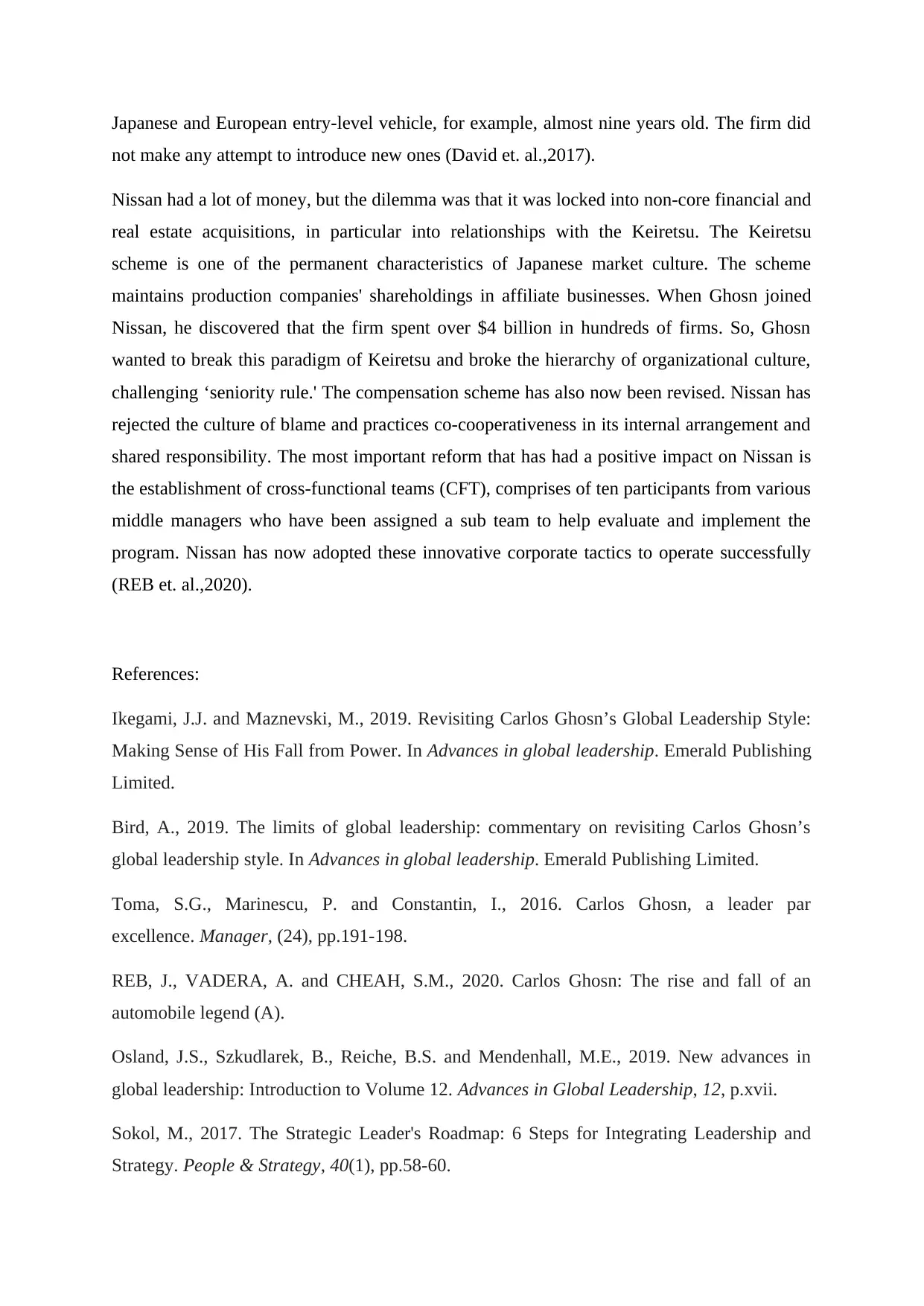Analysis of Leadership and Change Management at Nissan (MGT505)
VerifiedAdded on 2022/03/16
|6
|1661
|30
Report
AI Summary
This report provides an in-depth analysis of Carlos Ghosn's leadership and change management strategies at Nissan. It examines the company's financial crisis and the subsequent implementation of transformational leadership to restructure the organization. The report highlights Ghosn's use of cross-functional teams, communication strategies, and the application of Kotter's 8-step change model. It explores how Ghosn addressed cultural challenges, reduced costs, and improved brand image through various initiatives, including employee engagement and strategic partnerships. The analysis emphasizes the importance of clear vision, interpersonal skills, and culturally transcended leadership in driving organizational change. The report also discusses the significance of communication in fostering a participatory and democratic leadership style. Ultimately, the case study showcases how Ghosn successfully navigated Nissan through a period of significant transformation, offering valuable insights into effective leadership practices.

Assignment
Leadership and Change Management (MGT505)
Leadership and Change Management (MGT505)
Paraphrase This Document
Need a fresh take? Get an instant paraphrase of this document with our AI Paraphraser

1.
Nissan was already under a huge debt and sincerely required help with a renewed model of
management or collaboration. When Ghosn was officially appointed for the CEO at Nissan,
the first thing he did was to get a detailed overview of the recent condition of the company by
deploying cross-functional teams. It revealed that there were multiple areas that needed to be
refigured and re-establish. The sense of urgency was established when Ghosn used this crisis
of bankruptcy in a common platform of collective effort. He decided to reduce a number of
production plants which would eventually cause termination of jobs for more than 21000
Nissan employees, almost 14% of the production capacity of Nissan (Sudiantha et. al.,2017).
Working in a Japanese automaker firm, Ghosn understood that cultural amalgamation is
something that needs to be implemented in order to evoke a willingness to embrace a change
within the employee culture. He started with meeting the important team members and
discussed about ideas and approaches that can be taken. He also tactfully used the Yamaichi
bankruptcy story to make people aware that life employment is something that is not possible
anymore in Nissan and all of the involved parties have to successfully carry out their job to
save the company.
He used the information collected from the cross-functional teams and made the employees
aware that a simplification of production is imperative at this moment. He also sold
subsidiaries and offered good early retirement plan, opportunities for part time jobs to make
them understand the situation and act immediately without panicking.
2.
In this case, the best leadership theory that can be considered fit for describing Ghosn’s
approach in making change within the company structure is Transformational Leadership
style. One single attribute of Transformational leadership which is very prominent in case of
Ghosn’s leadership style is that he has been constantly accommodating the other teams of the
company to evaluate the crisis. He not only deployed a cross-functional team but also hired
Shiro Nakamura to get involved in car designs that can be more appealing to potential
Nissan was already under a huge debt and sincerely required help with a renewed model of
management or collaboration. When Ghosn was officially appointed for the CEO at Nissan,
the first thing he did was to get a detailed overview of the recent condition of the company by
deploying cross-functional teams. It revealed that there were multiple areas that needed to be
refigured and re-establish. The sense of urgency was established when Ghosn used this crisis
of bankruptcy in a common platform of collective effort. He decided to reduce a number of
production plants which would eventually cause termination of jobs for more than 21000
Nissan employees, almost 14% of the production capacity of Nissan (Sudiantha et. al.,2017).
Working in a Japanese automaker firm, Ghosn understood that cultural amalgamation is
something that needs to be implemented in order to evoke a willingness to embrace a change
within the employee culture. He started with meeting the important team members and
discussed about ideas and approaches that can be taken. He also tactfully used the Yamaichi
bankruptcy story to make people aware that life employment is something that is not possible
anymore in Nissan and all of the involved parties have to successfully carry out their job to
save the company.
He used the information collected from the cross-functional teams and made the employees
aware that a simplification of production is imperative at this moment. He also sold
subsidiaries and offered good early retirement plan, opportunities for part time jobs to make
them understand the situation and act immediately without panicking.
2.
In this case, the best leadership theory that can be considered fit for describing Ghosn’s
approach in making change within the company structure is Transformational Leadership
style. One single attribute of Transformational leadership which is very prominent in case of
Ghosn’s leadership style is that he has been constantly accommodating the other teams of the
company to evaluate the crisis. He not only deployed a cross-functional team but also hired
Shiro Nakamura to get involved in car designs that can be more appealing to potential

customers (Toma et. al.,2016). Transformational leaders are always keen for collaborations
and employment motivation which Ghosn did by providing financial support/benefit and
encouragement to the factory employees and the designers. He also took an unexpected
approach by closing off production plan in order to increase quality. transformative
leadership was embraced by Ghosn to manage the transition scenario and the context is best
suited for the overall and general view of a program-oriented approach to change
management and can be a core aspect in effective change management preparation for
Nissan.
3.
Despite all the doubts that initially prevailed while Ghosn was appointed as CEO , he
managed to create a change vision in the internal structure of the company and success.
The Kotter’s 8-step change model talks about creating a vision of change in an organizational
atmosphere. Despite all the doubts that initially prevailed while Ghosn was appointed as
CEO, he managed to create a change vision in the internal structure of the company and
successfully established a shared vision.
The traits and skills that actually helped him garner the support and bring about the change
includes –
Culturally transcended leadership: He was totally devoid of any cultural bias and always tried
to put the employees and organizational agenda ahead of himself and his priorities.
Interpersonal Skills: Ghosn turned out to be an expert intermediator between the two
companies- Nissan and Renault. He not only interacted with the employees but also
encouraged the designers and even convinced Shiro Nakamura to design cars for Nissan as
well (Bird, 2019).
Clear Vision: Ghosn was sincere enough to first evaluate the industry and then implementing
plans according to the need. He introduced a cross functional team for a better understanding
of the crisis, recruited a new designer and also regulated the company owned-dealership by
10% for increasing efficacy. He was even intelligent enough to not reveal the necessary
organizational changes that are going to happen since it had a probability to garner criticism
(Osland et. al.,2019). He thus invested on four fundamental objectives to carry out the
and employment motivation which Ghosn did by providing financial support/benefit and
encouragement to the factory employees and the designers. He also took an unexpected
approach by closing off production plan in order to increase quality. transformative
leadership was embraced by Ghosn to manage the transition scenario and the context is best
suited for the overall and general view of a program-oriented approach to change
management and can be a core aspect in effective change management preparation for
Nissan.
3.
Despite all the doubts that initially prevailed while Ghosn was appointed as CEO , he
managed to create a change vision in the internal structure of the company and success.
The Kotter’s 8-step change model talks about creating a vision of change in an organizational
atmosphere. Despite all the doubts that initially prevailed while Ghosn was appointed as
CEO, he managed to create a change vision in the internal structure of the company and
successfully established a shared vision.
The traits and skills that actually helped him garner the support and bring about the change
includes –
Culturally transcended leadership: He was totally devoid of any cultural bias and always tried
to put the employees and organizational agenda ahead of himself and his priorities.
Interpersonal Skills: Ghosn turned out to be an expert intermediator between the two
companies- Nissan and Renault. He not only interacted with the employees but also
encouraged the designers and even convinced Shiro Nakamura to design cars for Nissan as
well (Bird, 2019).
Clear Vision: Ghosn was sincere enough to first evaluate the industry and then implementing
plans according to the need. He introduced a cross functional team for a better understanding
of the crisis, recruited a new designer and also regulated the company owned-dealership by
10% for increasing efficacy. He was even intelligent enough to not reveal the necessary
organizational changes that are going to happen since it had a probability to garner criticism
(Osland et. al.,2019). He thus invested on four fundamental objectives to carry out the
⊘ This is a preview!⊘
Do you want full access?
Subscribe today to unlock all pages.

Trusted by 1+ million students worldwide

Organizational change – Brand image, successful collaborations, cost reduction in terms of
supply chin and purchasing cost and human resource and cultural practices.
4.
Communication turned out to be the most crucial factor in the Nissan case as Ghosn
effectively utilized a transparent communication channel with any cultural bias in leading the
change process. Frequent mistakes that interact with the coordination within the group are
able, at team, department or organizational level, to evolve into problems or crises. That is
why Ghosn is one of the leading businesses with considerable interest in dealing with
connectivity challenges in the companies he oversees. His orientation towards
communications shows that his style of leadership is participatory and democratic. Given that
Ghosn has a number of management tasks, he depended heavily on his staff, which also
reinforces the belief that he is a participatory boss. Kotter emphasizes the importance of
focusing on vision communication, since it can serve as a guidance, because if people do not
get the knowledge, they do not know the way to go (Sokol,2017). Mental pictures are easier
to recall, so symbols, analogies and illustrations are an efficient means of getting the meaning
across. In the Nissan 180 view, his 180 metaphor is therefore a paragon of goodness. It
clearly provides an image of turning the business around and adding the metrics in the 180's
made remembering what workers had to do simpler (Ikegami et. al.,2019). While such
leadership can create problems by the allowance of excessive freedom of action and decision-
making by subordinates, it can decide valuable outcomes for enterprises approached at
international levels. He believed that different circumstances demand different tactics and
different types of leadership. The leader should, in his view, show multiple dimensions that
should be conveniently extended by considering the causes and consequences of each case.
5.
At the end of the 1990s, when Ghosn was named CEO of Nissan, existing corporate practices
caused huge harm to the group. Nissan has been tied to currency, preventing him from
investing heavily in his ageing product range. The March (or Micra in Europe) was his
supply chin and purchasing cost and human resource and cultural practices.
4.
Communication turned out to be the most crucial factor in the Nissan case as Ghosn
effectively utilized a transparent communication channel with any cultural bias in leading the
change process. Frequent mistakes that interact with the coordination within the group are
able, at team, department or organizational level, to evolve into problems or crises. That is
why Ghosn is one of the leading businesses with considerable interest in dealing with
connectivity challenges in the companies he oversees. His orientation towards
communications shows that his style of leadership is participatory and democratic. Given that
Ghosn has a number of management tasks, he depended heavily on his staff, which also
reinforces the belief that he is a participatory boss. Kotter emphasizes the importance of
focusing on vision communication, since it can serve as a guidance, because if people do not
get the knowledge, they do not know the way to go (Sokol,2017). Mental pictures are easier
to recall, so symbols, analogies and illustrations are an efficient means of getting the meaning
across. In the Nissan 180 view, his 180 metaphor is therefore a paragon of goodness. It
clearly provides an image of turning the business around and adding the metrics in the 180's
made remembering what workers had to do simpler (Ikegami et. al.,2019). While such
leadership can create problems by the allowance of excessive freedom of action and decision-
making by subordinates, it can decide valuable outcomes for enterprises approached at
international levels. He believed that different circumstances demand different tactics and
different types of leadership. The leader should, in his view, show multiple dimensions that
should be conveniently extended by considering the causes and consequences of each case.
5.
At the end of the 1990s, when Ghosn was named CEO of Nissan, existing corporate practices
caused huge harm to the group. Nissan has been tied to currency, preventing him from
investing heavily in his ageing product range. The March (or Micra in Europe) was his
Paraphrase This Document
Need a fresh take? Get an instant paraphrase of this document with our AI Paraphraser

Japanese and European entry-level vehicle, for example, almost nine years old. The firm did
not make any attempt to introduce new ones (David et. al.,2017).
Nissan had a lot of money, but the dilemma was that it was locked into non-core financial and
real estate acquisitions, in particular into relationships with the Keiretsu. The Keiretsu
scheme is one of the permanent characteristics of Japanese market culture. The scheme
maintains production companies' shareholdings in affiliate businesses. When Ghosn joined
Nissan, he discovered that the firm spent over $4 billion in hundreds of firms. So, Ghosn
wanted to break this paradigm of Keiretsu and broke the hierarchy of organizational culture,
challenging ‘seniority rule.' The compensation scheme has also now been revised. Nissan has
rejected the culture of blame and practices co-cooperativeness in its internal arrangement and
shared responsibility. The most important reform that has had a positive impact on Nissan is
the establishment of cross-functional teams (CFT), comprises of ten participants from various
middle managers who have been assigned a sub team to help evaluate and implement the
program. Nissan has now adopted these innovative corporate tactics to operate successfully
(REB et. al.,2020).
References:
Ikegami, J.J. and Maznevski, M., 2019. Revisiting Carlos Ghosn’s Global Leadership Style:
Making Sense of His Fall from Power. In Advances in global leadership. Emerald Publishing
Limited.
Bird, A., 2019. The limits of global leadership: commentary on revisiting Carlos Ghosn’s
global leadership style. In Advances in global leadership. Emerald Publishing Limited.
Toma, S.G., Marinescu, P. and Constantin, I., 2016. Carlos Ghosn, a leader par
excellence. Manager, (24), pp.191-198.
REB, J., VADERA, A. and CHEAH, S.M., 2020. Carlos Ghosn: The rise and fall of an
automobile legend (A).
Osland, J.S., Szkudlarek, B., Reiche, B.S. and Mendenhall, M.E., 2019. New advances in
global leadership: Introduction to Volume 12. Advances in Global Leadership, 12, p.xvii.
Sokol, M., 2017. The Strategic Leader's Roadmap: 6 Steps for Integrating Leadership and
Strategy. People & Strategy, 40(1), pp.58-60.
not make any attempt to introduce new ones (David et. al.,2017).
Nissan had a lot of money, but the dilemma was that it was locked into non-core financial and
real estate acquisitions, in particular into relationships with the Keiretsu. The Keiretsu
scheme is one of the permanent characteristics of Japanese market culture. The scheme
maintains production companies' shareholdings in affiliate businesses. When Ghosn joined
Nissan, he discovered that the firm spent over $4 billion in hundreds of firms. So, Ghosn
wanted to break this paradigm of Keiretsu and broke the hierarchy of organizational culture,
challenging ‘seniority rule.' The compensation scheme has also now been revised. Nissan has
rejected the culture of blame and practices co-cooperativeness in its internal arrangement and
shared responsibility. The most important reform that has had a positive impact on Nissan is
the establishment of cross-functional teams (CFT), comprises of ten participants from various
middle managers who have been assigned a sub team to help evaluate and implement the
program. Nissan has now adopted these innovative corporate tactics to operate successfully
(REB et. al.,2020).
References:
Ikegami, J.J. and Maznevski, M., 2019. Revisiting Carlos Ghosn’s Global Leadership Style:
Making Sense of His Fall from Power. In Advances in global leadership. Emerald Publishing
Limited.
Bird, A., 2019. The limits of global leadership: commentary on revisiting Carlos Ghosn’s
global leadership style. In Advances in global leadership. Emerald Publishing Limited.
Toma, S.G., Marinescu, P. and Constantin, I., 2016. Carlos Ghosn, a leader par
excellence. Manager, (24), pp.191-198.
REB, J., VADERA, A. and CHEAH, S.M., 2020. Carlos Ghosn: The rise and fall of an
automobile legend (A).
Osland, J.S., Szkudlarek, B., Reiche, B.S. and Mendenhall, M.E., 2019. New advances in
global leadership: Introduction to Volume 12. Advances in Global Leadership, 12, p.xvii.
Sokol, M., 2017. The Strategic Leader's Roadmap: 6 Steps for Integrating Leadership and
Strategy. People & Strategy, 40(1), pp.58-60.

David, S., Armanu, A. and Afnan, T.E., 2017. The effects of transformational leadership and
personality on employee performance in Nissan Malang mediated by organizational
commitment. Russian Journal of Agricultural and Socio-Economic Sciences, 61(1).
Sudiantha, D., Armanu, A. and Troena, E.A., 2017. THE EFFECTS OF
TRANSFORMATIONAL LEADERSHIP AND PERSONALITY ON EMPLOYEE
PERFORMANCE IN NISSAN MALANG MEDIATED BY ORGANIZATIONAL
COMMITMENT. Russian Journal of Agricultural and Socio-Economic Sciences, (1),
pp.207-215.
personality on employee performance in Nissan Malang mediated by organizational
commitment. Russian Journal of Agricultural and Socio-Economic Sciences, 61(1).
Sudiantha, D., Armanu, A. and Troena, E.A., 2017. THE EFFECTS OF
TRANSFORMATIONAL LEADERSHIP AND PERSONALITY ON EMPLOYEE
PERFORMANCE IN NISSAN MALANG MEDIATED BY ORGANIZATIONAL
COMMITMENT. Russian Journal of Agricultural and Socio-Economic Sciences, (1),
pp.207-215.
⊘ This is a preview!⊘
Do you want full access?
Subscribe today to unlock all pages.

Trusted by 1+ million students worldwide
1 out of 6
Related Documents
Your All-in-One AI-Powered Toolkit for Academic Success.
+13062052269
info@desklib.com
Available 24*7 on WhatsApp / Email
![[object Object]](/_next/static/media/star-bottom.7253800d.svg)
Unlock your academic potential
Copyright © 2020–2025 A2Z Services. All Rights Reserved. Developed and managed by ZUCOL.





